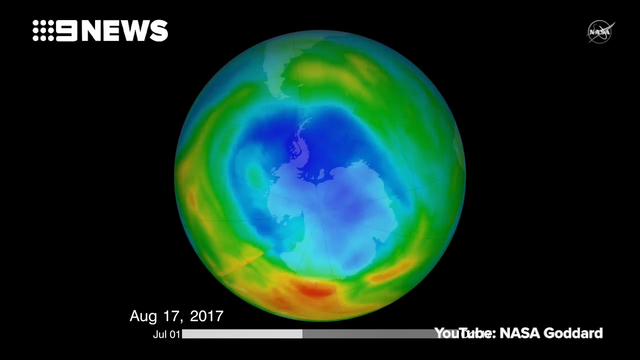Every day at dawn, I wake up to close the window facing the abattoir, some distance from our home. The acrid smell of burning tires used to fuel the fires and the billowing black soot from these fires have become our inescapable reality.
However, on the International Day for the Preservation of the Ozone Layer, I couldn’t help but ponder how this relentless pollution contributes to destroying something as vital as the ozone layer.
What is the ozone layer, and how are we destroying this protective canopy? Most importantly, what individual and collective actions can we take to preserve our beautiful shield?
I like to compare the ozone layer to a life-saving canopy that protects us from deadly burning rain.
FG: We’ll wield big stick on principals who boycott teaching
FG seeks enhanced financial inclusion as firm launches new banking app
The ozone layer is located in the earth’s stratosphere, 15- 40 kilometres above us. This canopy consists of three-atom ozone (O3) molecules that absorb and block harmful Ultra-Violet (UV) radiation from the sun while allowing life-sustaining sunlight to filter through.
Without this protective shield, unfiltered rays from the sun would hit us, leading to more skin cancers, cataracts, and harm to terrestrial and aquatic ecosystems.
Recognizing the urgent danger of the rapid depletion of the ozone layer, the United Nations negotiated the Montreal Protocol on Substances that Deplete the Ozone Layer in September 1987.
Adopted by 28 countries, this treaty aims to control the global production and consumption of Ozone Depleting Substances (ODS). Member Nations commit to reducing and phasing out ODS as science and technology advances.
In honour of the anniversary of the signing of the Montreal Protocol, the United Nations General Assembly designated September 16 as International Day for the Preservation of the Ozone Layer. The theme for this year is “Montreal Protocol: Restoring the Ozone Layer and Slowing Climate Change”.
Despite the strides made since the Montreal Protocol, threats to the ozone layer persist. Human activities, such as the use of ODS like chlorofluorocarbons (CFCs) and hydrochlorofluorocarbons (HCFCs), continue to threaten our beautiful canopy.
Additionally, the reckless release of air pollutants, such as the thick black soot from the abattoir behind our house, further compounds the depletion of this vital protective shield.
In the face of these threats, it is imperative to celebrate, support, and seek sustainable solutions that mitigate further damage to the ozone.
One promising solution lies in biogas production. For instance, the University of Benin’s ACTUATE team collects cattle rumen and dung from abattoirs. These organic materials are fed into biodigesters where fermentation takes place. The anaerobic digestion processes produce biogas, which is used to generate electricity.
What sets this practice apart is its environmental friendliness. Biogas is a sustainable and clean source of energy that can be used to burn cowhide instead of the commonly used, ecologically harmful tires.
By adopting renewable energy sources and improving waste management practices, abattoirs that embrace clean energy reduce their environmental footprint and contribute to preserving the ozone layer.
Hydroponic farming is another sustainable solution to preserving the ozone layer. This innovative agricultural method eliminates the need for soil, making it suitable for urban and rural settings.
Samson Ogbole, the founder of Soilless Farm Lab, is pioneering the adoption of hydroponic farming in Ogun State. Samson’s methods reduce land use and minimize the reliance on harmful chemical pesticides and fertilizers, indirectly alleviating the pressure on natural ecosystems and contributing to ozone layer preservation.
Carbon capture and storage (CCS) technology is another critical component of the sustainable solutions toolkit. A report by the US Environmental Protection Agency notes that Carbon dioxide is the primary greenhouse gas contributing to recent climate change.
In 2021, it accounted for 79 percent of all US greenhouse gas emissions from human activities, the report notes. CO2 emissions from cement factories, refineries, and power stations add more carbon dioxide to the atmosphere, contributing to climate change.
CCS involves capturing carbon dioxide (CO2) emissions, transporting them, and burying them permanently underground. By capturing and storing CO2 emissions, these initiatives prevent further pollution and actively remove CO2 from the atmosphere.
Considering the challenges and strides made in the race to net zero, the public and private sector need to implement a comprehensive set of actions. Below are some recommendations:
- Encourage Sustainable Technologies: Incentivize, regulate and collaborate with local communities and businesses to adopt eco-friendly technologies like biogas production.
- Invest in CCS Technology: Allocate funding and collaborate internationally on research and implementation of carbon capture and storage (CCS) technologies.
- Promote Hydroponic Farming: Offer training and research support for hydroponics tailored to Nigerian conditions.
- Strengthen Environmental Regulations: Enforce stricter regulations for industries emitting harmful pollutants and explore emissions trading or carbon pricing mechanisms.
- Encourage Sustainable Transportation: Promote clean public transportation and electric-powered vehicles. In this regard, the Lagos State electric-powered trains are a step in the right direction.
- Public Awareness and Education: Conduct nationwide awareness campaigns and integrate environmental education into school curricula.
- International Collaboration: Collaborate with international organizations and nations to share knowledge and access funding for ozone layer preservation.
- Monitoring and Reporting: Establish a robust monitoring system to track progress and report achievements and challenges internationally.
Hopefully, these interventions would heal and restore Earth’s life-saving canopy, the ozone layer.
Nora Agbakhamen, a Social Impact Storyteller and Climate Action Advocate, wrote in from Lagos State

